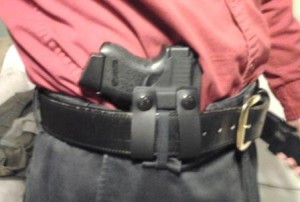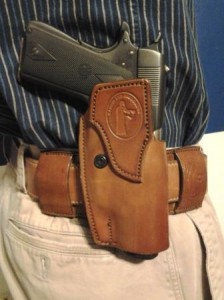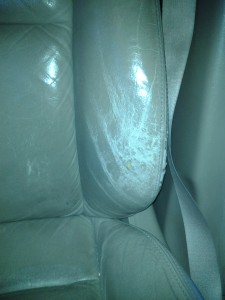Before I begin, you must use a holster if you carry a handgun. sticking it in your belt or sock is just stupid. http://www.theguardian.com/us-news/2016/may/16/us-man-shoots-himself-in-foot-while-adjusting-sock
Also Law Enforcement knows that criminals don’t use holsters and good guys do. Why? Guns are a tool to a criminal and if he must ditch the gun, they don’t want evidence they had a gun on them. So wear a holster!
It goes without saying, cheap holsters = crap, period. If you are paying under $50 the holsters is crap. Now more cost does not make it the best holster, however any holster I have ever bought that was under $50 turned out to be crap. The same goes with one size fits most holsters. Get one or more that are made for your specific weapon model, period, end of story.
Any holster must maintain its form to your pistol, so you can re-holster it one handed. Why you ask. What if you or a loved one are wounded and you need your hand(s) to apply pressure? Or one of your arms is injured? As Paul Markel says, “Good guys bleed too.” http://www.studentofthegun.com/
A thin leather like material will collapse when the gun is drawn, partially or wholly. This causes you to need to either force the barrel of you handgun into the holster, maybe causing a ND (Negligent Discharge), or causing you to reach around with your “free” hand and stretch the holster open, now you must point the barrel of the gun at your hand, always a bad idea.
There are a couple of ways manufacturers form holsters to specific handguns; one is the use of kydex to form either part of all of the holster. As a stiff “plastic” it retains its shape. Another common method of keeping the holsters form is thickening the leather and then forming it. There are other ways of making the holsters such as a frame of some sort between layers of leather.
You can check out my review of the different holsters I have used and tested by clicking on the “category” subject “Holsters” on the left-hand side of this page or by clicking here http://the22man.com/category/holsters/
Inside the Waistband (IWB) vs Outside the Waistband (OWB) carry:
First, remember, most training schools will not let you use a IWB holster for “Safety”, I disagree, if and that is a big IF you have a quality IWB holster, my CrossBreed and my draw are safe! Yes, I understand their concerns with multiple times drawing and holstering a gun. Hour after hour of this can and does cause fatigue. The theory of having an OWB holster at a training class, is that if there is a ND (negligent discharge) with and OWB holster, the chances of the bullet missing your body are greater than with an IWB holster.
An IWB holster has the big advantage of using your pants / skirt / kilt to “hide” at least part of your gun, making the “conceal” part of “conceal carry” a little easier. If the IWB holster has the clips that allow you to tuck in a shirt, this also allows you to wear a dressier shirt and pants. The days of the Hawaiian untucked shirt or the “camera” vest (now tactical vest) are long gone, it is time to leave the 80’s if you are still concealing that way. I’m not sayin’, I’m just sayin’.
In theory the OWB holsters are easier to draw and holster from. I disagree, the OWB holsters tend to drag my pants up more when drawing and push them down more when holstering. Before you think about it, yes I use and HIGHLY recommend a proper gun belt, not your JC Penny’s thin flimsy POS. I have used both and will never go back to the thin belts.
With the holster worn this way (OWB) the entire gun and holster are viewable if you try to tuck your shirt in. Another issue is the entire lower half of your weapon/ holster is exposed below your belt line. You must have a longer untucked shirt, jacket, vest or covering it up. Reaching up, bending over et al increases your chances of exposing your handgun thus no longer “concealing” it.
Loop location, on the holster or “spread out”:
Once you find a position that feels good to carry your firearm, you will run into a pair of your pants that does not cooperate. Different brands of pants put belt loops in slightly different locations both in height and distance apart. This causes the location of your holsters belt loops to conflict with the pants belt loops. It may seem insignificant, however, moving your holster even one inch can and will cause the holster to feel “different”. This may cause you to fidget when wearing the holster, which in turn will draw attention to yourself and the firearm, a major “no-no”.
In the pictures below, notice my belt notches and the location difference on my hip.



A difficulty with holsters like above it the weight of the handgun is all in one place. This can and will cause your pants to sag at the gun. How much so depends on how tight your belt is.
There are many holsters that have wider loops or belt clips that spread the weight farther across your waist. I really prefer these types.

High rise vs Low rise:
In belt holsters, there are different heights you can chose from. I am referring to how high the holster rides on your hip. A low rise tends to “hide” on your waist line better but getting a grip on the grip is normally more difficult. This tends to be used more for deep concealment, though I think if that is the need there are better options.
Most holsters are designed for what I will call a neutral height, where the grip is high enough to reach but the firearm barrel is still below the waist line.
The high rise application has a lot of merit. If you are seated, especially in a vehicle with your seatbelt on, it is phenomenally easier to grab the weapon and get it into action when compared to the other heights mentioned above. Especially when combined with an appendix or 2 o’clock carry position.
You can compare this high ride with the images above to get an idea of where the gun sits. It does jab my ribs if I lean to my right.

Appendix vs 3 o’clock, 6 o’clock vs kidney vs. Small of Back (SoB) carry:
Appendix carry has a quicker draw when standing and used most often when standing and at competitions. Everyday carry this way does cause the muzzle of the handgun to point at your thigh. If you have an accidental or negligent discharge you have a major wound, at the minimum and a shattered bone and femoral artery leak at the worse.
Appendix carry does make for easy opposite hand draw if necessary, just reach over, turn your reach / hand 180 degrees, grab the grip and go. Holstering is the same, and you have the advantage of being able to look and see not only the pistol but also the holster, resulting in a fairly safe environment and probably the safest way to re holster.
3 and 6 O’clock positions (depending if you are left or right handed) is generally the most “natural” for drawing your weapon. The non-dominant hand grabs your shirt on the opposite side of your body and yanks it up while your dominant hand goes to your hip and you draw the firearm.
The major disadvantage is the protrusion on your hip. This position causes the weapon or your body to stand out when people are facing you. It is less prominent if you have an IWB (Inside the Waistband) holster and a tucked in shirt. The OWB (Outside the Waistband) holsters tend to have the grip of the pistol further away from your body causing the gun to print more against your shirt.
If you have to draw with your opposite hand for one reason or another, or holster with your opposite hand, it is very difficult to reach the holster across your stomach or around your back, especially if you have shoulder issues or a gut sticking out.
Kidney carry is the 5 or 7 O’clock position around your waist, so the gun is behind you but not at your spine. The weapon is normally slightly “canted” making strong hand draw easier, after all trying to pull the gun straight up and out from behind you requires a certain dexterity that time and shoulder surgeries take away.
I personally consider this carry method the most concealable; however, if your handgun comes uncovered either by your shirt coming up or some other means, you cannot immediately tell. It is embarrassing when, at church the person in the row behind you leans over, touches your shoulder and says “your bat-gear is showing” during Amazing Grace, not that I have ever had that happen.
Even though this is a good way to conceal carry, you must remember to check your shirt / covering every time you stand up or sit down. Another thing to keep in mind is your draw stroke is more time consuming since you are reaching further and swinging your arm further around than say the appendix carry.
In my opinion, opposite hand draw or holstering, by reaching around your back is fairly easy, even after my shoulder surgery. You do lose site of the gun and must be conscience of where the muzzle is and where the holster is. Doing this “blind” can result in a negligent discharge fairly easily, so practice with an empty gun frequently*.
SoB (Small of Back) carry tilts the gun to almost a parallel to the ground level and “upside-down”, making offhand drawing (your non dominant hand) or holstering all but impossible.
When I see others drawing from this position they swing their arms wide, both arms, and swing their shoulders. This is a time consuming and very noticeable draw and you can easily laser a bunch of other people when doing this. It also has the concerns of not being able to see the gun as you draw and holster it. If you don’t get a good, correct grip when drawing, you have major issues, re aligning your hands takes critical moments that can mean life and death.
I will hopefully be submitting some reviews on a couple of SoB holsters over the next year.
SOB and shoulder rigs should not be used in training classes. There are safety and lasering (pointing the barrel of a weapon at yourself or another – if a laser beam was coming out of the barrel what would it hit?) of others or yourself when drawing the weapon from the holsters, and of course when re-holstering too. Of course, to be honest, with almost any carry you do actually laser yourself either drawing or holstering or both.
Cross Draw Holsters are where you reach across your body, so if you are right handed the holster is on the left appendix area and you reach across your body to grab the gun. Even though you may be thinking of old cowboy days, there are new IWB and OWB holsters available. I have no experience with these and thus have no input for you.
Flap holsters: A major no-no. No article on belt holsters would be complete without mentioning your grandfathers WWII flap holster. Just say “no”. For CCW, hunting or any other reason, I see no reason for a flap holster unless it is in a shadowbox on the wall with an ancient unusable firearm with it.
Wear and tear on your car:
One more thing to consider with ALL holsters, the wear and tear on your chairs and vehicles seats. I am a lefty but right eye dominant so I carry, most of the time on the right side. As you can see by my car seats, right hand carry damages driver side seats less, because you turn and pivot to your left when getting out of your vehicle. I do know these seats are more curved to the body than truck bench seats. This is just to provide a reminder of one more thing to consider.



*I highly recommend practice drawing the gun 5 to 10 times a day, preferably every morning, to get your body used to the draw. Remember they gun MUST be empty and triple checked. I use an air soft that looks and feels like my Glock for safety.
Until we meet again, Keep your booger hooker off the trigger!







2 thoughts on “Pistol Conceal Carry holsters: Hip (belt) holsters”
Comments are closed.